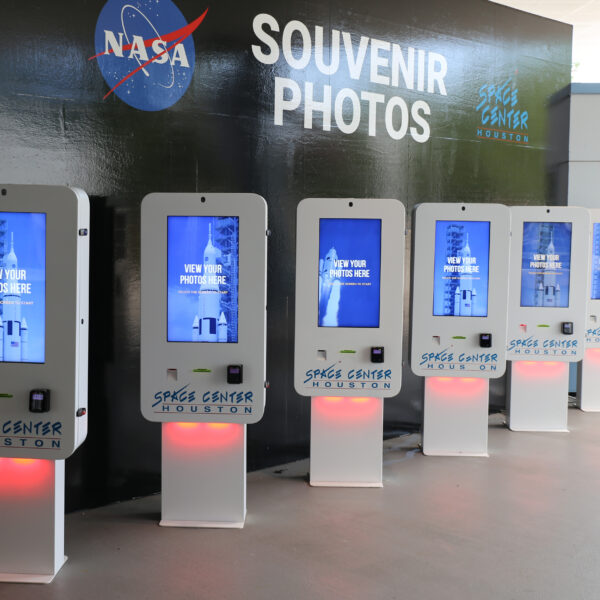
Kiosks
Close
Kiosk Industries


With self-service on the rise across countless industries, it’s no surprise the popularity of outdoor kiosks has also increased. From ticket dispensing to wayfinding, and everything in between, these kiosks are great tools to provide information, sell products or services, and help customers navigate outdoor areas.
Because of their use cases, these kiosks, like indoor kiosks, often require internet connection. Fortunately, businesses have multiple options for outdoor kiosk connectivity, including Ethernet, Wi-Fi, Cellular, and even Hybrid connectivity. It's a matter of finding the best fit for your needs.
One of the most reliable methods of connecting an outdoor kiosk to the internet is through an Ethernet connection. Ethernet is a type of wired network connection that transmits data through cables. It’s often the preferred choice for outdoor kiosks due to its stability and security.
With an Ethernet connection for outdoor kiosks, the data that is sent between devices has a lower chance of being disrupted by external factors, like signal dropouts, fluctuations, or interference from other wireless devices.
Additionally, Ethernet connections provide a high level of security. Because the connection is through a physical cable, it reduces the risk of unauthorized access or data breaches which are more common in wireless networks. This makes an Ethernet connection for outdoor kiosks a particularly suitable choice for kiosks handling sensitive information like payment processing.
Furthermore, Ethernet connections are generally more reliable in terms of speed and performance. They can handle high-speed data transmission without significant performance drops, ensuring the kiosks performs quickly and offers an ideal user experience.
If your kiosk is located near a building, setting up internet connectivity can be as simple as running an Ethernet cable to the back of the kiosk. If the kiosk is located further, a cable will need to run through an electrical conduit that connects through the base of the kiosk. Typically, this involves the help of an electrician.
To help with this process, kiosk manufacturers can provide site preparation documents that include mounting instructions, electrical requirements, and suggested conduit placement.
Although setting up Ethernet connections for outdoor kiosks can be more complex and may require professional assistance, the long-term advantages of stability, speed, and security make it the best option.
An alternative method to provide internet connectivity to an outdoor kiosk is through a wireless Wi-Fi connection. This is the easiest and most cost-effective option if there is an existing Wi-Fi network onsite.
Wi-Fi offers certain advantages over Ethernet for outdoor kiosks, such as allowing for greater flexibility in terms of kiosk placement. Without the constraints of physical cables, kiosks can be located where they will be most effective, even in more remote areas.
However, a Wi-Fi connection may be susceptible to interference and disruptions caused by other devices, weather conditions, or a weak signal. So, the kiosk will need to be in closer proximity to the Wi-Fi network to ensure a strong and stable connection. This can sometimes be a challenge in an outdoor environment.
To help improve the Wi-Fi signal, an external Wi-Fi antenna can be mounted to the outside of the kiosk to strengthen the connection.
Setting up outdoor kiosks that utilize Wi-Fi is typically faster, eliminating the need for complicated wiring. This can result in lower installation costs and faster deployment.
In a more remote environment or cases where there are no Ethernet or Wi-Fi networks available onsite, a cellular router can be placed within the kiosk that uses 4G LTE or 5G. Something to keep in mind is that the cellular option can be more expensive with a monthly cellular contract needed for the router device.
Cellular connectivity ensures seamless and uninterrupted connectivity, providing a stable connection anywhere with a good cellular signal. Like when using Wi-Fi, an external cellular antenna can improve the signal of the cellular network, which will increase its reliability.
If Ethernet and Wi-Fi are not options, cellular connections can ensure a stable and consistent performance, even in high-demand situations.
A hybrid connection involves using a combination of Ethernet, Wi-Fi, or cellular connection to ensure uninterrupted internet connectivity. Each of the above connection types has its drawbacks, so using one or more of them together can help provide a more reliable connection.
For instance, you could use Ethernet as the primary connection and cellular as a backup in case of failure. That way, if the Ethernet connection stops working, the kiosk can seamlessly switch to cellular as a backup, ensuring uninterrupted connectivity and maintaining operations.
This use of dual connections ensures a strong and reliable network infrastructure, keeping data flowing smoothly and reducing downtime.
Having reliable outdoor kiosk connectivity is essential.
When choosing an ideal connectivity solution, it’s important to consider the costs, reliability of the connection, security, and compatibility of the devices and locations. Being mindful of an outdoor kiosk program’s connectivity needs means businesses can enjoy the benefits of uninterrupted connection at optimal speeds.